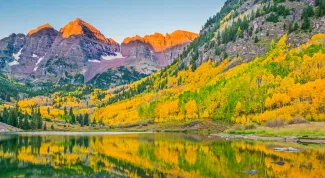Standing at more than 14,000 feet, the Maroon Bells, a series of distinctively bell-shaped, wine-colored peaks of mudstone, carved out over 300 million years, are the most photographed mountains in North America, and is Aspen’s number one summer destination. During peak season, there may be crowds. To avoid large crowds, we suggest visiting mid-week, arriving with the first bus of the day.
How To Aspen Guides
Maroon Bells Tips
Getting to the Maroon Bells
- Getting to the Maroon Bells is best done by bus.
- Read this Getting to the Maroon Bells blog post for bus and car information.
Cycling to the Maroon Bells
- The road to the Maroon Bells is also a popular cycling route.
- With a steady eight-mile climb to the Maroon Bells’ parking lot, this ride is a perfect intermediate to advanced experience, with local tour groups offering daily trips throughout summer.
Hiking around the Maroon Bells
- With six scenic hiking trails beginning at the base of the Bells, there is a variety of terrain easily accessed from the parking lot or the RFTA bus drop off.
- The trails surrounding Maroon Lake are fairly flat and are wheelchair and stroller accessible. These lead to more challenging routes in the Maroon Bells-Snowmass Wilderness Area.
- Upon arrival to the Bells, be mindful of preparation, as there is no drinking water at this site, but there are bathrooms.
Maroon Bells to the Backcountry
- The Maroon Bells is a perfect starting point for many backcountry hikes including the popular West Maroon Pass to Crested Butte, Buckskin Pass and the Four Pass Loop.
- The peaks of the Maroon Bells themselves – Maroon and North Maroon – are rated 3 and 4 degrees of hiking difficulty, respectively.
- They are extremely exposed and unstable routes, giving them the notorious moniker, “The Deadly Bells.” Please be realistic with your abilities, and when in doubt, hire a guide.

